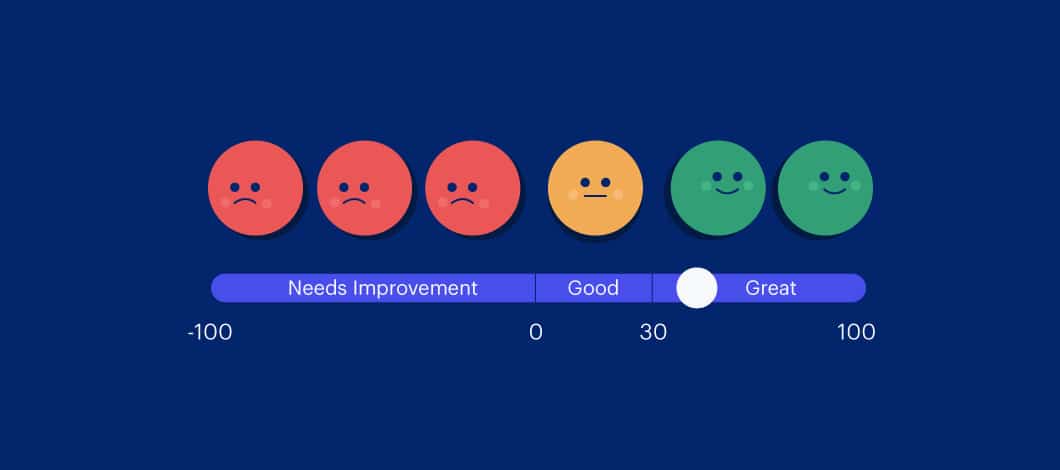Net Promoter Score (NPS) is one of today’s most important ways to measure customer satisfaction. Here’s how to track and improve it.
Learn how to use this valuable tool to measure and manage customer satisfaction.
What Is Net Promoter Score?
NPS is a metric used to measure the customer experience of a brand and predict how likely customers are to recommend a business to friends or colleagues.
The term is a registered trademark of the developers of NPS: business strategist Frederick F. Reichheld, global management consulting firm Bain & Co. and customer experience-management software provider Satmetrix.
Reichheld introduced the concept of NPS in a Harvard Business Review article in 2003. Since then, it has become one of the most popular ways to measure customer satisfaction.
What NPS Measures
NPS measures what percentage of your customers are highly likely to recommend you to friends and colleagues as rated on a numerical scale. The standard NPS scale ranges from 0 to 10. The score is determined through customer surveys which ask a question such as, typically, “How likely is it that you would recommend our company to a friend or colleague?”
The question can be worded slightly differently to suit your needs. For instance, you can ask how likely the customer would be to recommend a specific product or service rather than your company. If you serve a consumer market rather than a business market, you might ask how likely they would be to recommend you to friends and family rather than colleagues.
Advanced applications of the NPS methodology may involve asking multiple questions. For example, some surveys may seek to gauge satisfaction with different aspects of customer experience or of a product or service. However, asking too many questions can waste customers’ time and discourage the completion of surveys, so most NPS questionnaires stick to a handful of questions.
Many surveys include one or more questions with a comment box so that customers can offer additional feedback. For instance, you might ask, “What is the primary reason for your score?” This can be useful for identifying factors influencing customer scores.
Elements of NPS: Promoters, Detractors and Passives
Customers who respond with a high score of 9 to 10 on a 0 to 10 scale are classified as promoters because they are highly likely to recommend you. A customer who responds with a low score of 0 to 6 is classified as an NPS detractor because they aren’t likely to recommend you and are more likely to spread negative word-of-mouth about your brand. Customers who fall in the range of 7 to 8 are classified as passives who could lean either way.
NPS measures the net difference between the number of your customers who are promoters and those who are detractors. Passives are factored out for purposes of calculating your NPS measurement.
What NPS Tells You
Your NPS score tells you what proportion of your customers are highly enthusiastic about your brand. This serves both to measure customer satisfaction and to predict how likely customers are to buy from you again and to refer you to new customers. In this way, NPS helps predict your brand’s future revenue and growth, making it a highly important key performance indicator.

How Do You Calculate Net Promoter Score?
The Net Promoter Score calculation is straightforward. To calculate NPS, you can follow a simple 3-step procedure:
- Survey your customers by asking a question such as, “On a scale of 0 to 10, how likely are you to recommend our company to a friend or colleague?”
- Divide responses into those from 0 to 6 (detractors), 7 to 8 (passives) and 9 to 10 (promoters).
- Ignoring passives, subtract your percentage of promoters from your percentage of detractors to yield your NPS score.
Because the third step converts the net difference between your promoters and detractors into a percentage, with a positive or negative value depending on whether your promoters outnumber your subtractors, NPS score ranges from -100 to 100. A score of -100 would indicate that 100% of your customers are detractors. A score of 100 would indicate that all 100% of your customers are promoters.
To illustrate, let’s say you survey 100 customers. After categorizing your results, you find that 10 customers are detractors, 70 are passive and 20 are promoters. Your NPS score would be 20 minus 10, or 10.
To simplify your calculation, you can use an online NPS calculator.
How Do You Track Your Net Promoter Score?
To track your score, you first need to design an NPS survey questionnaire. There are 2 main types of NPS surveys:
- Relationship surveys, which measure a customer’s overall experience of your brand
- Transactional surveys, which measure a customer’s experience during a particular transaction with your brand, such as their satisfaction with a product they purchased or with your handling of a customer support ticket
The type of NPS survey you intend to make will determine which types of questions you should ask. For transactional surveys, focus on places in your customer journey where your customers interact with you most frequently. For example, an ecommerce website might find it helpful to survey customers about their experience with using the site’s shopping cart.
Here are some Net Promoter Score question examples:
- On a scale of 0 to 10, how likely are you to recommend our company to a friend or colleague?
- On a scale of 0 to 10, how likely are you to recommend our product to a friend or colleague?
- On a scale of 0 to 10, how likely are you to recommend our company to a friend or colleague as a good place to work?
- What is the primary reason for your score?
- What could we do to improve your experience?
Select the questions most relevant to your survey goals. Limiting your survey to 3 to 5 questions is recommended to avoid placing too much of an imposition on customers. If you want to give customers an opportunity to provide additional feedback, include a comment box and an option to be contacted.
Questions for relationship surveys are typically sent out periodically on a regular schedule, such as once a quarter or twice a year. Transactional surveys can be scheduled or sent out after a customer has engaged in a particular type of transaction, such as a purchase or customer support inquiry.
NPS surveys usually are sent via email or text message. Messages should be personalized and short and include a link to your survey form. For example, you might send an email with a subject line saying, “Please take 2 minutes to complete a customer feedback survey”.
The body of the email might say something like, “At our company, we’re constantly trying to improve our service and we’d like your feedback on our performance. Please take 2 minutes to complete a few short questions about your recent customer experience by clicking on the link below. We promise to read every customer comment. Thanks for your feedback!”
To increase the survey response rate, send a follow-up reminder to customers who haven’t completed their survey after 3 to 7 days.

How Do You Evaluate Your Net Promoter Score?
What is a good NPS rating? According to survey provider SurveyMonkey, the average NPS score across all industries globally is 32, while the average score varies for different industries.
For professional services and in consumer goods and services, the average score is 43, while for technology companies the average is 35. Bain says that a score above 50 is excellent, while a score above 80 is considered world-class.
Keep in mind these numbers can vary considerably within industries and niches. If possible, find information about the NPS scores or your main competitors. This can give you an idea what number you should be aiming to exceed. Satmetrix provides comparative NPS benchmarking scores for different industries.
How Can You Improve Your Net Promoter Score?
A valuable use of NPS for small business is that tracking your score puts you in a position to improve it. You can take a number of steps to improve your NPS score:
- Reach out to detractors in an effort to make amends
- Listen to negative feedback from detractors, and identify where in their customer journey snags are occurring and need to be corrected
- Look for patterns in detractor complaints to identify the most frequent problems which need to be addressed
- Listen to positive feedback from promoters, and identify anything you’re doing right which could be scaled up
- Review your customer support performance and procedures to identify areas for improvement
- Assign your tech support team to improve your site’s user experience design
Use these strategies to turn your NPS score into a springboard for improving customer satisfaction levels, turning your customers into repeat buyers of your products and promoters of your brand.
Track Your Net Promoter Score to Promote Customer Satisfaction
Tracking your NPS gives you some insight into how satisfied your customers are and how likely they are to recommend your brand. This gives you an opportunity to identify impediments to customer satisfaction and take corrective measures.
Make NPS surveys part of your standard operating procedures in order to manage your customer relations and promote higher satisfaction with your brand. The results will be greater customer loyalty, more referrals and higher profit margins.










